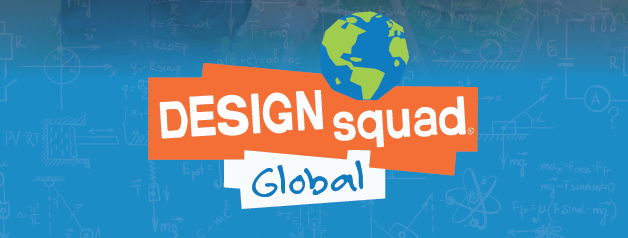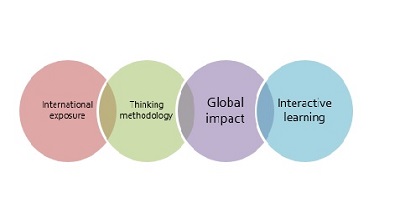Design Squad Global Clubs

*If interested in joining a future edition, please write to Ms. Sarah Kuhail (KuhailS@alnayzak.org). Ms. Kuhail will be coordinating the DSGCs initiative under the umbrella of NAMES and the outputs will be shared through the network’s communication channels on regular basis.
Design Squad Global Clubs (DSGCs) are interactive learning opportunities that kids around the world engage with to explore engineering and invention with international partners. Participants use the design process to solve problems and discover engineering as a powerful tool for making a difference in the world. They also begin to develop their "global competency": the ability to communicate and collaborate with people from different backgrounds, cultures, and perspectives.
DSGCs aim to connect students, 10-13 years of age, with international peers, to collaborate and work together around design thinking methodology. The program aims to equip students with technical tools that can be integrated in their daily lives. Most importantly, students connect the activities to the UN Sustainable Development Goals to achieve global impact.

In August 2017, Al-Nayzak Organization for Supportive Education and Scientific Innovation was invited by the Association of Science-Technology Centers (ASTC) to take part in the DSGC initiative in partnership with the Creative Discovery Museum in Chattanooga, USA, with the participation of 20 students.
What is the Design Squad Global Club?
It is an interactive program that connects different students, 10-13 years old, from the whole world outside school times to explore the design thinking process and engineering skills by using safe, cheap, and simple materials. Children explore engineering through fun-packed, high-energy, and hands-on activities, while partnering with a DSG club from a different country.
The club could be implemented at any scientific/educational center in two forms, 6 weeks or 12 weeks, and includes two main parts:
- Part one: engineering and invention challenges, where students are introduced to hands-on engineering activities and the design process.
- Part two: the partnering project, where students create their own original engineering projects according to UN Sustainable Development Goals.
Collaboration opportunities within NAMES network
Following the implementation of DSGC at Al-Nayzak, one of NAMES members, NAMES foresees the up-scale of this program across its members, especially as it has proven to be extremely engaging, interactive, and entertaining for participants. Most importantly, the program proved to be a good learning opportunity for participants as it offers a new methodology of thinking, and as it helps connect participants to peers from different locations, creating an international exposure and a diverse experience.
1- Let’s start with Webinars!
NAMES envisions the coordination of learning webinars for its members. A series of webinars could be conducted, where previous experience will be shared, resources are explored, and collaborations are established between members.
2- Let’s team up!
NAMES members could team up, or could reach out to potential scientific partners in other networks. This will be a good opportunity to create exposure of NAMES and its members on an international platform.
As teams are established, partners get to work together, setting an action plan, using the online resources, and collaborating in real time to implement activities with participants. Peers from different centers/ museums will have the chance to connect and learn from one another.
3- Disseminating Experience
NAMES could coordinate an international webinar to showcase its achievements and new partnerships. This could be supported by a lot of social media exposure to create buzz. This could also be in line with the ISCSMD. Partners will be invited to present their work and highlight success stories and potential for improvements.
Why should students join the DSGC?
Because it is:
- A unique opportunity to work with partner clubs across the globe and share ideas with peers from different places.
- A program that can develop design thinking, sharing, communication, and learning skills.
- A global competency.
What is the target group?
The target group for this course is students from 10-13 years old.
What is the recommended group size?
- It is recommended to be between 12-14 participants.
- It is better to have an even number of participants since in most activities they work in pairs, especially in the first part.
How to select the target group?
You could use different tools to promote the project and select participants. You could visit schools, or even announce on social media, reaching out to enthusiasts and lovers of engineering, designing, and fabricating.
What about DSGC sessions?
- 12 sessions implemented over 12 weeks (one session per week).
- Sessions are built on each other, so it is recommended that participants are committed to attending all sessions.
- Sessions are segmented into 2 parts; the first 6 sessions focus on learning the process of design thinking, while the next part focuses on implementing the participants’ projects.
- Each session can be 60-120 minutes long; it depends on the session itself and the students’ discussion. However, two hours is recommended in all sessions.
- Each session has different requirements; you mainly need a basic hall with basic technologies (projector, laptop, etc.). More details are available in the user manual.
- Most of the sessions include sharing your results/ experiences with your partner clubs.
What are your HR needs?
- A qualified trainer with passion who can encourage students (it is better if he/she has knowledge in the basics of the design thinking process).
- A volunteer who can help and support the trainer during the session implementation.
What should a DSGC leader do?
- Prepare for each session (materials, worksheets, translation “if needed”);
- Lead the sessions;
- Encourage participants to interact;
- Ask questions, encourage participation and innovation;
- Share worksheets, photos, and videos with the club partner;
- Facilitate interaction among partner clubs.
What about activities?
Activities are easy to comprehend, challenging to implement; they are creative and innovative. All activities are interactive and require participants to work with their hands. The activities focus on engineering and learning the design thinking process (define, ideate, prototype, testing, valuation, rebuild, etc.). All activities addressed the UN SDGs; you can select the goal you wish to tackle within your activities, and direct participants’ projects accordingly.
What about the training materials?
All the materials can be found in the manual; they are safe, cheap, and easily found. Moreover, alternative materials are found as a second option.
What is the main challenge?
In every session, participants encounter a challenge that they need to solve. They go through a process of problem identification and finding solutions. This encourages participation and creative thinking; above all, it allows participants to implement the design thinking methodology.